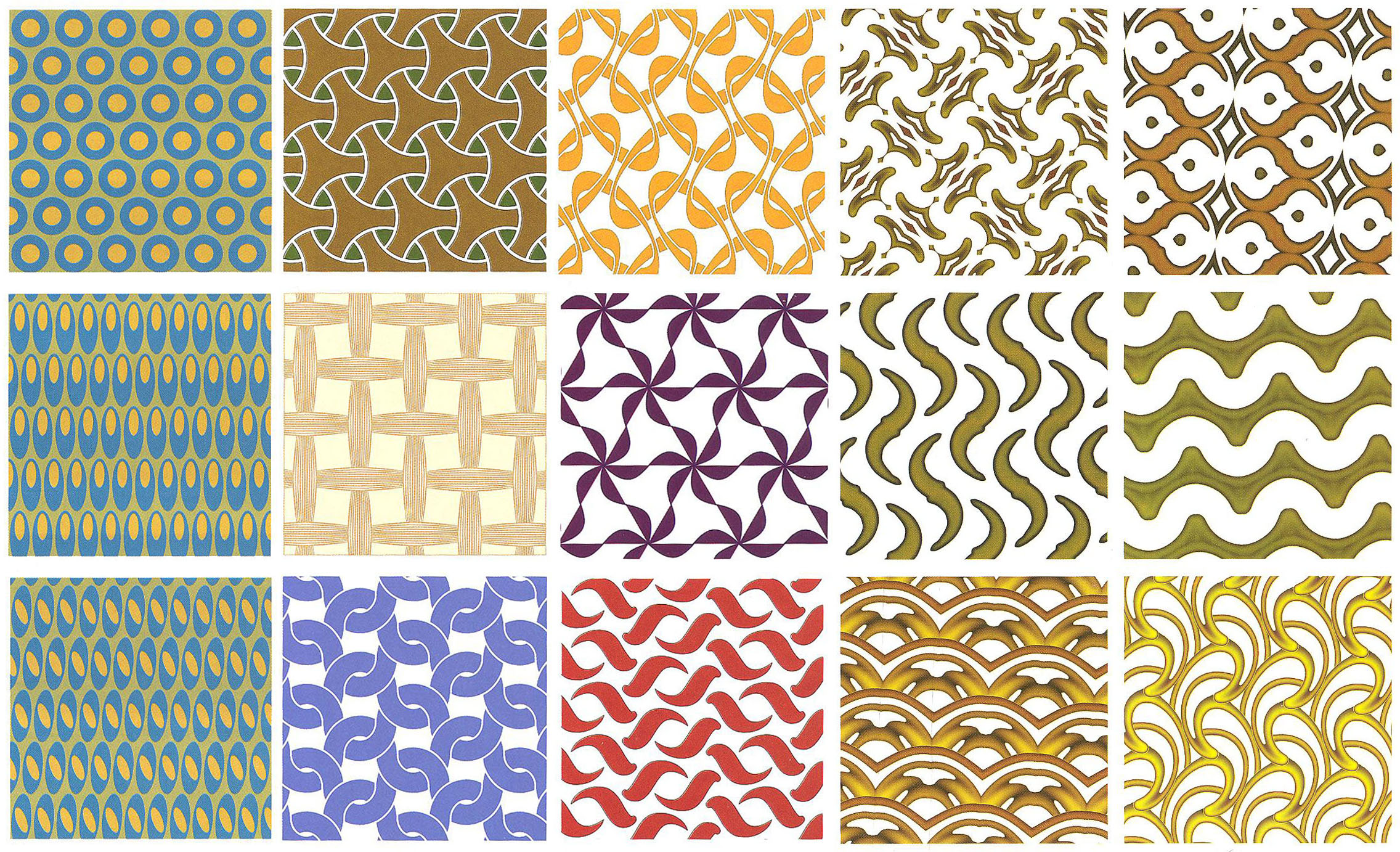CS 39R: Symmetry & Topology
Lecture #10 -- Mon. 4/15, 2013.
PREVIOUS <- - - - > CS 39R HOME < - - - - > CURRENT < - - - - > NEXT
Find matching
pairs with the same symmetries (rows 1, 2,
3; columns A, B, C, D, E).

For each pattern make a list of all symmetries found in the
linear friezes and in the round hub caps; compare those lists!
Which symmetries are
found in both classes? Which are found in only one of
them? (Make a Venn diagram)
HUBCAPS
BOTH
FRIEZES
(
Cn>2, Dn>2,
(
mirrors, C2,
D2,
)
glide
axes
)
In the above patterns: 2A == 3D; 1D
== 2B; 1C == 2D == 3B == 3C.
Wall-Paper Symmetries
Which of the above symmetries apply to tessellations of
the plane?
=> Cn, Dn, only for n =
2,3,4,6.
Are there any new ones? =>
No.
A wonderful, "must-have"
resource (from which the above pictures originated):
"The Symmetries
of Things" by John H. Conway, Heidi Burgiel and Chaim
Goodman-Strauss (A.K.Peters, Wellesley, MA, 2008)
Let's make a list of all the symmetries that we are
looking for!
Introducing the John H. Conway
notation for describing symmetries. (JHC and polyhedra)
sym2
sym1 sym3 sym4 sym5 sym6 sym7 sym8
Multiple mirror planes. Kaleidoscopes. Look for different
corners!
In how many ways can we combine all these elements in 2
dimensions?
pg42
pg43
There are exactly 7 types of
linear friezes.
How many wallpaper types are there?
WpGrps
The Magic Theorem.
Cost
for each symmetry item
With the "costs" listed in the above table for each symmetry
element in a wallpaper design,
the total cost for every periodic wall paper is always
the same: 2 units ($)!
Apply the Conway notation to hubcaps.
Apply the Conway notation to friezes. (friezes)
Intermission: Fill out
questionnaire.
How do we capture the symmetry of finite objects (the 14
families that we talked about in Lecture
#3 )?
==> Embed the object in the celestial sphere. Thus
let's study the symmetries of spherical tessellations!
Which ones of all the symmetry
types encountered so far apply to the surface of a sphere?
=> They must accommodate a spherical triangle that can
seamlessly tessellate a sphere:
"Lunes" going from pole to pole of any count: 2 to infinity;
"Half-lunes" going from the equator to one pole any
count: 2 to infinity;
Triangles that can make up the faces of a Platonic solid.
What is new if we go to 3-dimensional lattices?
List possible new symmetries!
=> Helical screw axes.
How many 3-dimensional crystal lattice types ?
=> 230 types, in 32 possible crystal classes, within 7
crystal systems.
Your Project Presentations Next Week
Pick one or two interesting issues that make a good story
(rather than a superficial overview of all possible
issues that one could address).
Final Homework Assignments:
Work on your projects! ( ... a
crucial part of getting a passing grade in this course!)
Prepare for Monday,
4/22/2013:
an 8-minute (15min. for 2-person teams) formal presentation
with visuals (and possibly models).
E-mail me your official title and your main findings (in
one or two sentences),
before Friday, 4/19/2013, midnight.
(I will use that information to plan the sequence of the
presentations.)
Practice your talk (and time it) !
PREVIOUS <- - - - > CS 39R HOME < - - - - > CURRENT < - - - - > NEXT
Page Editor: Carlo H. Séquin
